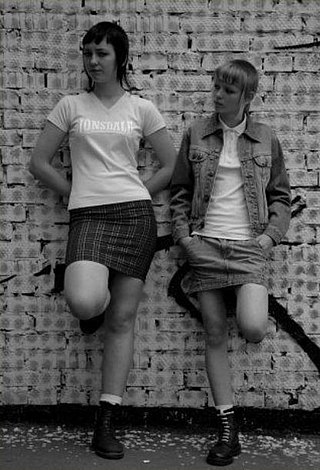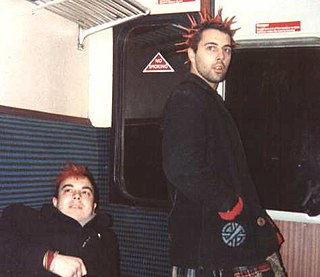
The punk subculture includes a diverse and widely known array of ideologies, fashion, and other forms of expression, visual art, dance, literature, and film. Largely characterised by anti-establishment views, the promotion of individual freedom, and the DIY ethics, the culture originated from punk rock.

A skinhead or skin is a member of a subculture that originated among working-class youths in London, England, in the 1960s. It soon spread to other parts of the United Kingdom, with a second working-class skinhead movement emerging worldwide in the late 1970s. Motivated by social alienation and working-class solidarity, skinheads are defined by their close-cropped or shaven heads and working-class clothing such as Dr. Martens and steel toe work boots, braces, high rise and varying length straight-leg jeans, and button-down collar shirts, usually slim fitting in check or plain. The movement reached a peak at the end of the 1960s, experienced a revival in the 1980s, and, since then, has endured in multiple contexts worldwide.

Punk fashion is the clothing, hairstyles, cosmetics, jewellery, and body modifications of the punk counterculture. Punk fashion varies widely, ranging from Vivienne Westwood designs to styles modeled on bands like The Exploited to the dressed-down look of North American hardcore. The distinct social dress of other subcultures and art movements, including glam rock, skinheads, greasers, and mods have influenced punk fashion. Punk fashion has likewise influenced the styles of these groups, as well as those of popular culture. Many punks use clothing as a way of making a statement.

Leather subculture denotes practices and styles of dress organized around sexual activities that involve leather garments, such as leather jackets, vests, boots, chaps, harnesses, or other items. Wearing leather garments is one way that participants in this culture self-consciously distinguish themselves from mainstream sexual cultures. Many participants associate leather culture with BDSM practices and its many subcultures. For some, black leather clothing is an erotic fashion that expresses heightened masculinity or the appropriation of sexual power; love of motorcycles, motorcycle clubs and independence; and/or engagement in sexual kink or leather fetishism.

A waistcoat or vest is a sleeveless upper-body garment. It is usually worn over a dress shirt and necktie and below a coat as a part of most men's formal wear. It is also sported as the third piece in the traditional three-piece male suit. Any given waistcoat can be simple or ornate, or for leisure or luxury. Historically, the waistcoat can be worn either in the place of, or underneath, a larger coat, dependent upon the weather, wearer, and setting.

Heavy metal fashion is the style of dress, body modification, make-up, hairstyle, and so on, taken on by fans of heavy metal, or, as they are often called, metalheads or headbangers. While the style has changed from the 1970s to the 2020s, certain key elements have remained constant, such as black clothes, long hair and leather jackets. In the 1980s, some bands began wearing spandex. Other attire includes denim or leather vests or jackets with band patches and logos, t-shirts with band names, and spiked wristbands.

A jacket is a garment for the upper body, usually extending below the hips. A jacket typically has sleeves and fastens in the front or slightly on the side. A jacket is generally lighter, tighter-fitting, and less insulating than a coat, which is outerwear. Some jackets are fashionable, while others serve as protective clothing. Jackets without sleeves are vests.

Rockers are members or followers of a biker subculture that originated in the United Kingdom during the late 1950s and was popular in the 1960s. It was mainly centred on motorcycles and rock 'n' roll music. By 1965, the term greaser had also been introduced to Great Britain and, since then, the terms greaser and rocker have become synonymous within the British Isles, although used differently in North America and elsewhere. Rockers were also derisively known as Coffee Bar Cowboys. Their Japanese counterpart was called the Kaminari-Zoku.

Western wear is a category of men's and women's clothing which derives its unique style from the clothes worn in the 19th century Wild West. It ranges from accurate historical reproductions of American frontier clothing, to the stylized garments popularized by Western film and television or singing cowboys such as Gene Autry and Roy Rogers in the 1940s and 1950s. It continues to be a fashion choice in the West and Southwestern United States, as well as people associated with country music or Western lifestyles, for example the various Western or Regional Mexican music styles. Western wear typically incorporates one or more of the following: Western shirts with pearl snap fasteners and vaquero design accents, blue jeans, cowboy hat, a leather belt, and cowboy boots.

Fashion in the 1990s was defined by a return to minimalist fashion, in contrast to the more elaborate and flashy trends of the 1980s. One notable shift was the mainstream adoption of tattoos, body piercings aside from ear piercing and, to a much lesser extent, other forms of body modification such as branding.

Denim and Leather is the fourth studio album by English heavy metal band Saxon released in 1981. The album was certified Gold status in the U.K. This was the last album with the classic line up of Saxon, as drummer Pete Gill would leave the band due to a hand injury, later joining Motörhead; this was also seen as the last of their trilogy of classic albums.

Fashion of the 1980s was characterized by a rejection of 1970s fashion. Punk fashion began as a reaction against both the hippie movement of the past decades and the materialist values of the current decade. The first half of the decade was relatively tame in comparison to the second half, which was when apparel became very bright and vivid in appearance.

Workwear is clothing worn for work, especially work that involves manual labour. Often those employed within trade industries elect to be outfitted in workwear because it is built to provide durability and safety.

A shell jacket is a garment used as part of a military uniform. It is a short jacket that reaches down to hip level. It was very common in the mid and late 19th century. The jacket was first created in Austria.

Stone washing is a textile manufacturing process used to give a newly manufactured cloth garment a worn appearance. The process became popular in the 1980s, as acid jeans gained popularity; however, stone washing has roots going back to 1960s surfer apparel. Stone washing also helps to increase the softness and flexibility of otherwise stiff and rigid fabrics such as canvas and denim. Although stone washing increases a fabric's flexibility, it shortens the life-span of the jeans. The process of stone washing can be costly, as freshly stone washed jeans must be washed many times in order to remove the grit from the process. Along with high production costs, stone washing can be detrimental to the environment, due to the excess grit that is removed as fabric is being stone washed. This leads many manufacturers to pursue other methods to achieve a distressed appearance.

A poseur is someone who poses for effect, or behaves affectedly, who affects a particular attitude, character or manner to impress others, or who pretends to belong to a particular group. A poseur may be a person who pretends to be what they are not or an insincere person; they may have a flair for drama or behave as if they are onstage in daily life.

A leather jacket is a jacket-length coat that is usually worn on top of other apparel or item of clothing, and made from the tanned hide of various animal skins. The leather material is typically dyed black, or various shades of brown, but a wide range of colors is possible. Leather jackets can be designed for many purposes, and specific styles have been associated with subcultures such as greasers, motorcyclists, and bikers, mobsters, military aviators and music subcultures, who have worn the garment for protective or fashionable reasons, and occasionally to create a potentially intimidating appearance.

A scooterboy is a member of one of several scooter-related subcultures of the 1960s and later decades, alongside rude boys, mods and skinheads. The term is sometimes used as a catch-all designation for any scootering enthusiast who does not fall into the latter three categories.

Fans of heavy metal music, commonly referred to as "Metalheads", have created their own subculture that encompasses more than just appreciation of the style of music. Fans affirm their membership in the subculture or scene by attending metal concerts, buying albums, growing their hair long, wearing jackets or vests often made of denim and leather adorned with band patches and often studs, and by contributing to metal publications since the early 1980s.

Biker metal is a fusion genre that combines elements of punk rock, heavy metal, rock and roll and blues, that was pioneered in the late-1970s to early-1980s in England and the United States, by Motörhead, Plasmatics, Anti-Nowhere League and Girlschool.
























